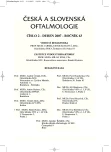The Use of the Toric Intraocular Lens in Treatment of Complicated Cataract and High Degree Astigmatism
Authors:
J. Urminský; P. Rozsíval; V. Lorencová; A. Feuermannová
Authors‘ workplace:
Oční klinika LF UK a FN, Hradec Králové, přednosta
prof. MUDr. P. Rozsíval, CSc.
Published in:
Čes. a slov. Oftal., 63, 2007, No. 2, p. 82-90
Overview
The authors refer about highly effective and in our ophthalmology not yet described method of surgical treatment of complicated cataract in patients with high degree of preexisting astigmatism over 3.0 cylindrical diopters. According to the etiology of astigmatism, in the group, there are patients with cataract and high ametropia after previous corneal transplantation and patients with cataract and preexisting high ametropia without any previous surgery. The referred group consists of 14 patients (19 eyes), and 9 of them (9 eyes) underwent in the past penetrating keratoplasty (PK) due to keratoconus at our department. The common sign of this subgroup was unsatisfactory postoperative refraction and later on the progressive cataract development. The other part of the group consisted of 5 patients (5 eyes) and they underwent no surgery in the past. For the surgical treatment of cataract and astigmatism at once we have used the individually manufactured silicone toric intraocular lens made by the company Human Optics (type MS 6116 TU). The average age of the whole group at the time of the cataract surgery was 51.5 ± 6.8 years (range, 39–66 years). The group consisted of 8 women (57.1 %) and 6 men (42.9 %). The average duration of the period between the keratoplasty and the cataract surgery was 4.8 ± 3.6 years. The uncorrected visual acuity before the cataract surgery was 0.10 ± 0.11, and the best-corrected visual acuity was 0.39 ± 0.22. The average value of the preoperative refractive error was +3.4 ± 5.0 dioptres (range, -11.0 to +10.0 dioptres) and -6.4 ± 2.3 cylindrical dioptres (range, -12.0 to -3.0 cylindical dioptres). The average follow up period was 9.6 months (range, 4–18 months). In the postoperative period we noticed improving of the uncorrected visual acuity to the value 0.50 ± 0.26, and the best-corrected visual acuity improved finally to 0.56 ± 0.26. The final average refractive error decreased to 0.44 ± 0.86 dioptres and -1.8 ± 0.77 cylindrical dioptres.
Key words:
corneal transplantation, astigmatism, cataract, toric intraocular lens
Labels
OphthalmologyArticle was published in
Czech and Slovak Ophthalmology

2007 Issue 2
Most read in this issue
- Intraoperative Floppy Iris Syndrome
- Orbital Apex Syndrome of the Aspergilus Ethiology – a Case Report
- The Cooperation between the Ophthalmologist and the Endocrinologist in the Treatment of the Endocrine Orbitopathy
- Functional Examination of Retinal Vessels in Patients with Central Retinal Vein Occlusion
